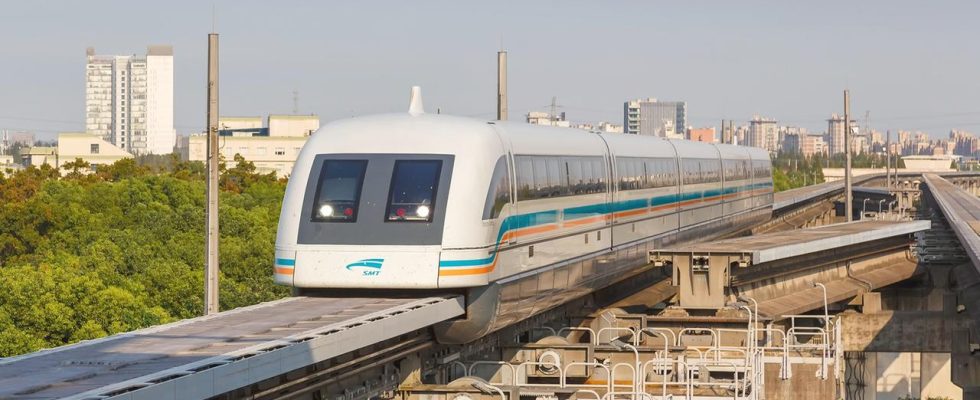The Transrapid was once the epitome of German cutting-edge technology. This was also the beginning of an era for China: in 2002, the first commercial Transrapid route was opened in Shanghai. What happened to her?
Anyone who visits the magnetic levitation train museum in Shanghai takes a journey back in time to Emsland. It goes back to 1983, to the former Transrapid test track. German technology and German engineering are upheld in this museum. It is the basis for what has been floating over the tracks in Shanghai two floors above the museum from the Transrapid train station for a good 20 years: the world’s first commercial magnetic levitation train, also known as Maglev.
Federal Transport Minister Kurt Bodewig sent the Transrapid to Shanghai in 2002. For China, it should be the beginning of a new era in rail transport.
70-year-old Ma Gouxing remembers the construction. He lives near the 30-kilometer-long Transrapid line in the eastern part of Shanghai in Pudong. “I watched with friends how the Maglev station was being built at the airport. It was almost finished at that time,” he says. Today, Ma rides the subway, crowded with people – like many Shanghainese.
In the shadow of the subway
7.30 a.m. at the Transrapid train station on the eastern edge of Shanghai on Longyang Lu: Here you can change from the subway to the magnetic levitation train towards the airport. It doesn’t look really modern here anymore, even if you can still sense a hint of the futuristic feel that the station once had in the early 2000s. Compared to the subway, there isn’t much going on here.
A ticket for the magnetic levitation train in Shanghai costs the equivalent of around 6.50 euros – a ticket for the subway from the city center to the airport only costs around 90 cents. Zhang Luping regularly commutes to work with the Maglev. “If I didn’t work for the airport, I wouldn’t use the maglev,” he says. “Maybe when I go on vacation, but I’m sure I wouldn’t use it often.” It is too expensive for that.
There is a special rate for airport staff, but most of the other business travelers we meet travel at the expense of the company they work for.
The Transrapid competes with the subway, which is significantly cheaper. (Photographed September 2019)
Operators are slowing down
The 30 kilometer journey takes eight minutes. The speed can be observed on a display; it is accelerating rapidly. But it no longer reaches the spectacular 430 kilometers per hour (km/h) that it once was. 301 km/h top speed, just as fast as a bullet train on China’s railway lines. The operator of the magnetic levitation train has reduced the speed during the corona pandemic and wants to save costs. The utilization was therefore too low.
Cost efficiency has always been a problem for maglev trains, both in Germany and China. Other projects such as building the Transrapid line to Hangzhou, around 160 kilometers away, or extending it to the city of Nanjing have failed.
Zhao Jian, a professor of economic management at Jiaotong University in Beijing, said: “The Shanghai Maglev has been operating for so many years and has made serious losses.” The train does not have enough passengers.
Record-breaking track could follow
In 2021, the People’s Republic presented a magnetic levitation train that, according to state media, will reach a top speed of 600 km/h. This would make the train, developed by China itself and manufactured in the coastal city of Qingdao, the fastest ground vehicle in the world. According to the information, from Shanghai you could be in the capital Beijing, more than 1,200 kilometers away, within two and a half hours. But so far this is just theory.
Zhao believes that this is not feasible and that there are still many questions unanswered. “The train has been built, but there is still no test whether this technology is reliable and whether it can go into commercial operation. It has not yet been tried on test tracks,” he says.
But still a future? China has introduced its own magnetic levitation train.
There is still no breakthrough
Huang Jingyu, on the other hand, is more optimistic. At the time, he was involved in the Shanghai Maglev project – together with German experts – and is conducting research at the National Magnetic Levitation Technology Center at Tongji University in Shanghai.
According to the researcher, China’s research into the 600 km/h magnetic levitation train began in 2016 and is based on German technology from 2001. “We then continued to research it independently. China is a huge country, a railway network with high-speed trains is enough not enough to handle all the passenger traffic,” says Huang. He sees a complementary relationship between railways and magnetic levitation. “Both can work.”
But so far, the magnetic levitation train has not been able to establish itself as a means of transport in China either.

